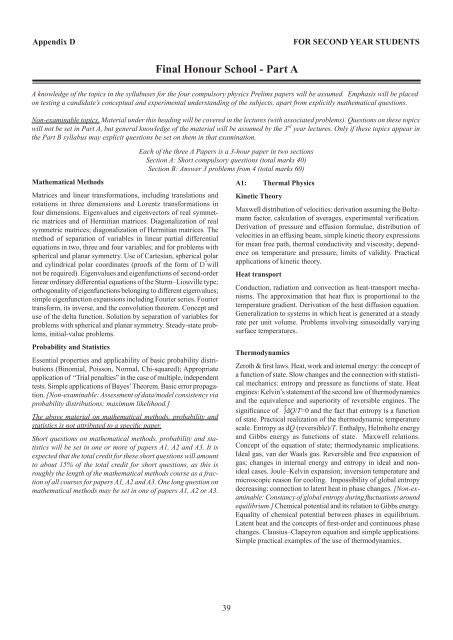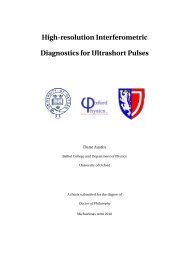Undergraduate Course Handbook - University of Oxford Department ...
Undergraduate Course Handbook - University of Oxford Department ...
Undergraduate Course Handbook - University of Oxford Department ...
You also want an ePaper? Increase the reach of your titles
YUMPU automatically turns print PDFs into web optimized ePapers that Google loves.
Appendix D<br />
FOR SECOND YEAR STUDENTS<br />
Final Honour School - Part A<br />
A knowledge <strong>of</strong> the topics in the syllabuses for the four compulsory physics Prelims papers will be assumed. Emphasis will be placed<br />
on testing a candidate’s conceptual and experimental understanding <strong>of</strong> the subjects, apart from explicitly mathematical questions.<br />
Non-examinable topics. Material under this heading will be covered in the lectures (with associated problems). Questions on these topics<br />
will not be set in Part A, but general knowledge <strong>of</strong> the material will be assumed by the 3 rd year lectures. Only if these topics appear in<br />
the Part B syllabus may explicit questions be set on them in that examination.<br />
Mathematical Methods<br />
Matrices and linear transformations, including translations and<br />
rotations in three dimensions and Lorentz transformations in<br />
four dimensions. Eigenvalues and eigenvectors <strong>of</strong> real symmetric<br />
matrices and <strong>of</strong> Hermitian matrices. Diagonalization <strong>of</strong> real<br />
symmetric matrices; diagonalization <strong>of</strong> Hermitian matrices. The<br />
method <strong>of</strong> separation <strong>of</strong> variables in linear partial differential<br />
equations in two, three and four variables; and for problems with<br />
spherical and planar symmetry. Use <strong>of</strong> Cartesian, spherical polar<br />
and cylindrical polar coordinates (pro<strong>of</strong>s <strong>of</strong> the form <strong>of</strong> D 2 will<br />
not be required). Eigenvalues and eigenfunctions <strong>of</strong> second-order<br />
linear ordinary differential equations <strong>of</strong> the Sturm–Liouville type;<br />
orthogonality <strong>of</strong> eigenfunctions belonging to different eigenvalues;<br />
simple eigenfunction expansions including Fourier series. Fourier<br />
transform, its inverse, and the convolution theorem. Concept and<br />
use <strong>of</strong> the delta function. Solution by separation <strong>of</strong> variables for<br />
problems with spherical and planar symmetry. Steady-state problems,<br />
initial-value problems.<br />
Probability and Statistics<br />
Essential properties and applicability <strong>of</strong> basic probability distributions<br />
(Binomial, Poisson, Normal, Chi-squared); Appropriate<br />
application <strong>of</strong> “Trial penalties” in the case <strong>of</strong> multiple, independent<br />
tests. Simple applications <strong>of</strong> Bayes’ Theorem. Basic error propagation.<br />
[Non-examinable: Assessment <strong>of</strong> data/model consistency via<br />
probability distributions; maximum likelihood.]<br />
The above material on mathematical methods, probability and<br />
statistics is not attributed to a specific paper.<br />
Short questions on mathematical methods, probability and statistics<br />
will be set in one or more <strong>of</strong> papers A1, A2 and A3. It is<br />
expected that the total credit for these short questions will amount<br />
to about 15% <strong>of</strong> the total credit for short questions, as this is<br />
roughly the length <strong>of</strong> the mathematical methods course as a fraction<br />
<strong>of</strong> all courses for papers A1, A2 and A3. One long question on<br />
mathematical methods may be set in one <strong>of</strong> papers A1, A2 or A3.<br />
Each <strong>of</strong> the three A Papers is a 3-hour paper in two sections<br />
Section A: Short compulsory questions (total marks 40)<br />
Section B: Answer 3 problems from 4 (total marks 60)<br />
A1: Thermal Physics<br />
Kinetic Theory<br />
Maxwell distribution <strong>of</strong> velocities: derivation assuming the Boltzmann<br />
factor, calculation <strong>of</strong> averages, experimental verification.<br />
Derivation <strong>of</strong> pressure and effusion formulae, distribution <strong>of</strong><br />
velocities in an effusing beam, simple kinetic theory expressions<br />
for mean free path, thermal conductivity and viscosity; dependence<br />
on temperature and pressure, limits <strong>of</strong> validity. Practical<br />
applications <strong>of</strong> kinetic theory.<br />
Heat transport<br />
Conduction, radiation and convection as heat-transport mechanisms.<br />
The approximation that heat flux is proportional to the<br />
temperature gradient. Derivation <strong>of</strong> the heat diffusion equation.<br />
Generalization to systems in which heat is generated at a steady<br />
rate per unit volume. Problems involving sinusoidally varying<br />
surface temperatures.<br />
Thermodynamics<br />
Zeroth & first laws. Heat, work and internal energy: the concept <strong>of</strong><br />
a function <strong>of</strong> state. Slow changes and the connection with statistical<br />
mechanics: entropy and pressure as functions <strong>of</strong> state. Heat<br />
engines: Kelvin’s statement <strong>of</strong> the second law <strong>of</strong> thermodynamics<br />
and the equivalence and superiority <strong>of</strong> reversible engines. The<br />
significance <strong>of</strong> ∫dQ/T=0 and the fact that entropy is a function<br />
<strong>of</strong> state. Practical realization <strong>of</strong> the thermodynamic temperature<br />
scale. Entropy as dQ (reversible)/T. Enthalpy, Helmholtz energy<br />
and Gibbs energy as functions <strong>of</strong> state. Maxwell relations.<br />
Concept <strong>of</strong> the equation <strong>of</strong> state; thermodynamic implications.<br />
Ideal gas, van der Waals gas. Reversible and free expansion <strong>of</strong><br />
gas; changes in internal energy and entropy in ideal and nonideal<br />
cases. Joule–Kelvin expansion; inversion temperature and<br />
microscopic reason for cooling. Impossibility <strong>of</strong> global entropy<br />
decreasing: connection to latent heat in phase changes. [Non-examinable:<br />
Constancy <strong>of</strong> global entropy during fluctuations around<br />
equilibrium.] Chemical potential and its relation to Gibbs energy.<br />
Equality <strong>of</strong> chemical potential between phases in equilibrium.<br />
Latent heat and the concepts <strong>of</strong> first-order and continuous phase<br />
changes. Clausius–Clapeyron equation and simple applications.<br />
Simple practical examples <strong>of</strong> the use <strong>of</strong> thermodynamics.<br />
39










![Extended Notes 8 [pdf]](https://img.yumpu.com/50123548/1/190x245/extended-notes-8-pdf.jpg?quality=85)




![Handout 3 [pdf] - University of Oxford Department of Physics](https://img.yumpu.com/46475432/1/190x245/handout-3-pdf-university-of-oxford-department-of-physics.jpg?quality=85)